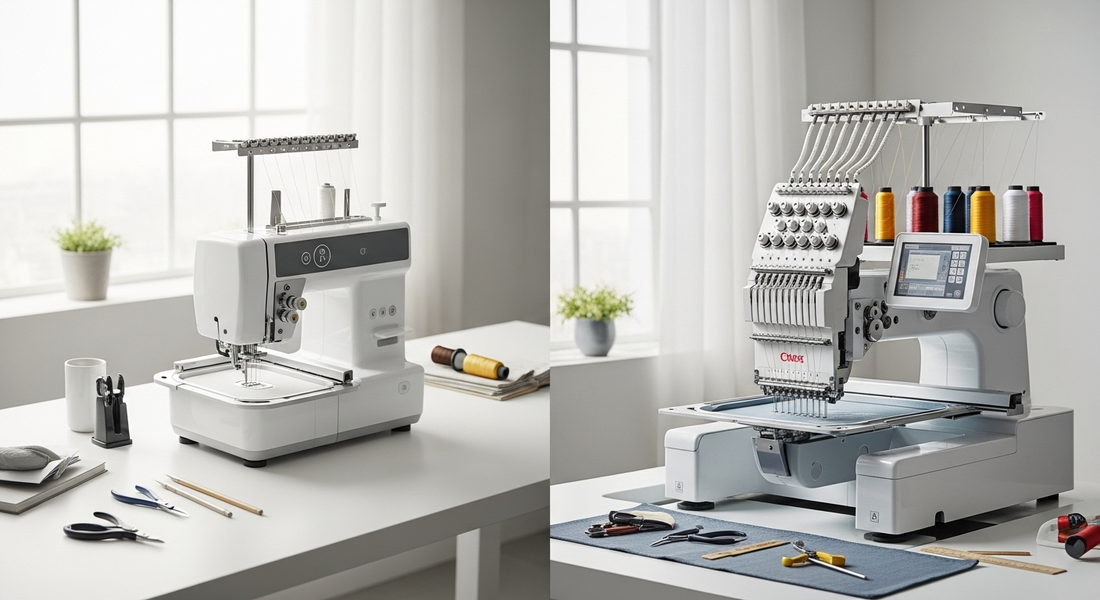
Single-Needle vs. Multi-Needle Embroidery Machines: What I Learned the Hard Way
Share
When I first got into machine embroidery, I thought the biggest challenge would be learning how to thread the darn machine. Turns out, choosing the right machine in the first place was an even bigger deal. One of the first decisions I had to make—and one I still get asked about all the time—is whether to go for a single-needle machine or take the leap and invest in a multi-needle one.
If you’re sitting on that same fence, I get it. Here's what I’ve learned, not from reading manuals or spec sheets, but from actual, sometimes frustrating, hands-on experience.

So, What’s a Single-Needle Machine Really Like?
Think of it like this: a single-needle machine is the cozy, dependable car that gets you around town. It won’t win races, but it gets the job done and doesn’t ask too much of you.
Mine looked and sounded a lot like a regular sewing machine when I first set it up. One spool of thread, one needle, and a handful of built-in designs to play with. For a beginner, it was perfect.
Why it worked for me at first:
- It was affordable, so I didn’t feel like I was taking a huge risk.
- I could keep it on a small desk in the corner of the room.
- It came with a screen that actually made sense (and I’m not very techy).
- It also let me sew, which meant I didn’t need a second machine.
What eventually got on my nerves:
- Changing thread for every color was... exhausting. Especially on larger pieces.
- If I messed up the alignment even a little, it threw everything off.
- Some designs were just too big or too detailed for the limited hoop size.

And Then... I Met the Multi-Needle Beast
Okay, not literally a beast—but it looked intimidating at first. The machine had multiple needles (mine has ten), and each one could hold a different color thread. No more stopping to re-thread every time the design changed colors. That alone felt like magic.
Why I fell in love (after the panic subsided):
- It worked like a small production machine. Fast, smooth, precise.
- My work started to look and feel more professional.
- It could handle bulkier fabrics, like denim or fleece, without skipping a beat.
- I didn’t need to babysit the machine while it worked.
But let me be real:
- It was expensive. Like, really expensive.
- I had to make space. These machines are not small.
- The first few weeks were a learning curve—menus, needles, tension settings...
- Maintenance is real. When something goes wrong, you need to know your machine.
A Quick and Honest Comparison
|
Feature |
Single-Needle |
Multi-Needle |
|
Price |
Friendly for beginners |
A serious investment |
|
Thread Changes |
All manual |
Automatic and smooth |
|
Speed |
Slower (especially with colors) |
Much faster |
|
Ideal For |
Hobbyists, occasional stitching |
Business, frequent large orders |
|
Size |
Compact |
Takes up more room |
|
Learning Curve |
Gentle |
Steeper, but worth it |
So… Which One Should You Get?
Here’s my take:
If embroidery is something you're exploring, or if you're just making gifts and fun pieces now and then, a single-needle machine is more than enough to bring joy. Start there. Learn. Grow. Fall in love with the craft.
But if you're taking commissions, planning to open an Etsy store, or you already know this isn’t just a hobby for you—it’s worth saving up for a multi-needle machine. It will save you time, elevate your quality, and honestly, make the process way more enjoyable once you’re past the learning curve.
One Last Thought
At the end of the day, no machine will do the work for you. It’s your hands, your eye, and your persistence that make a project beautiful. But the right machine? It’ll definitely make the ride smoother.